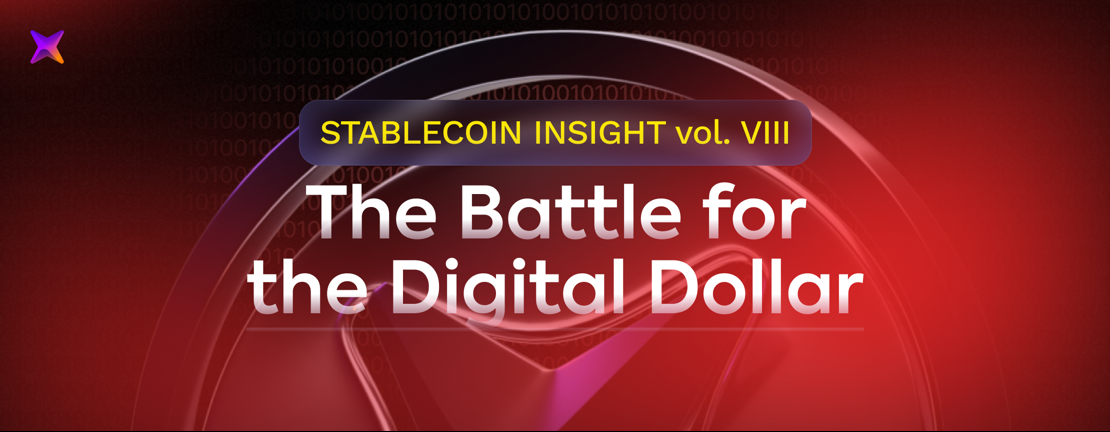Published: 14 Nov 2025
Stablecoins vs CBDCs: Who Wins the Digital Dollar Race

By late 2025, the global race to define the future of digital money has entered its decisive phase.
Two competing models are now shaping that future: stablecoins, driven by private innovation, and central bank digital currencies (CBDCs), steered by state oversight.
Stablecoins already move hundreds of billions of dollars monthly, powering payments, trading, and on-chain finance worldwide.
CBDCs, on the other hand, have advanced through pilots and controlled rollouts — the digital yuan in China, the digital euro in testing, and the U.S. digital dollar still under study.
Both aim to modernize money. But their philosophies diverge sharply:
-
Stablecoins prioritize access, interoperability, and programmability — building open financial rails.
-
CBDCs focus on trust, regulation, and systemic control — embedding digital currency into existing frameworks.
This report examines how these two systems coexist, where they overlap, and which model is currently leading the digital dollar race.
The comparison highlights not only market dynamics but also the deeper question behind the numbers — who truly defines the future of money: code or central banks?
Key Takeaways — Private Innovation vs Public Control
The global digital money landscape has split into two dominant paths — one built by open protocols, the other by central banks.
Each model pursues the same goal — stability, speed, and trust — but through fundamentally different architectures.
-
Stablecoins evolve faster because they operate in open markets. Innovation cycles are short, and upgrades happen without political bottlenecks.
-
CBDCs move slowly but with institutional weight — every rollout aligns with regulatory, legal, and monetary policy frameworks.
-
Stablecoins have achieved global reach first, with users in over 180 countries and 250B USD in circulating supply.
-
CBDCs, while smaller in scale, are gaining legitimacy and integration into domestic financial systems.
-
The competition is not binary. In many economies, hybrid models are emerging — regulated stablecoins supervised by central banks.
The outcome of this race won’t be decided by ideology but by efficiency and adoption.
Stablecoins currently dominate cross-border usage, while CBDCs are establishing infrastructure for the long term.
Together, they are redefining what money means in a programmable, global economy.
Comparison Framework — How the Two Systems Differ
The gap between stablecoins and CBDCs isn’t just regulatory — it’s architectural.
They differ in governance, design, accessibility, and the degree of control they impose on users.
While both are digital representations of value, their underlying logic reveals two distinct ideologies of money.
The table below summarizes the key contrasts shaping their evolution:
Stablecoins vs CBDCs (2025 Comparison)
| Dimension | Stablecoins | CBDCs |
|---|---|---|
| Governance | Private issuers and protocols | Central banks and public institutions |
| Infrastructure | Built on public blockchains (Ethereum, Tron, Solana) | Operate on closed, permissioned systems |
| Privacy | Pseudonymous, user-controlled wallets | KYC-bound, full identity traceability |
| Speed of Innovation | Rapid, market-driven upgrades | Slow, policy-dependent evolution |
| Accessibility | Global and borderless | Domestic use with legal restrictions |
| Integration | DeFi, fintech, and payments ecosystems | Centralized banking networks |
| Resilience | Redundant, open networks | Centralized nodes and national hosting |
| Policy Role | Market innovation and liquidity growth | Monetary control and financial stability |
Insight
Stablecoins thrive on market adaptability — they move where liquidity flows.
CBDCs, in contrast, anchor financial sovereignty and compliance, prioritizing oversight over flexibility.
As a result, each system appeals to a different type of trust:
-
Users trust stablecoins because they are transparent and interoperable.
-
Governments trust CBDCs because they are controlled and auditable.
This tension defines the structure of the modern digital currency landscape — open innovation versus centralized assurance.
Global Map — Adoption and Implementation 2025
By 2025, the digital money landscape spans nearly every major economy — but with very different levels of maturity between CBDCs and stablecoins.
Over 130 central banks are exploring CBDCs, with about 40 in pilot or advanced testing.
Meanwhile, stablecoins already operate in production, settling billions daily across multiple chains and platforms.
Asia leads the CBDC rollout:
-
China’s e-CNY is live in over 25 cities and integrated into public payment apps.
-
Hong Kong and Singapore continue cross-border CBDC testing with the Ubin+ and mBridge projects.
Europe is running limited pilots for the digital euro, while the United States is still in early policy research through the Digital Dollar Project.
In contrast, stablecoins like USDT, USDC, and PYUSD are widely adopted across Latin America, Africa, and Southeast Asia — powering remittances, payrolls, and e-commerce.
Global Distribution Snapshot (2025)
| Region | CBDC Status (2025) | Stablecoin Activity |
|---|---|---|
| China | Pilot stage (e-CNY) | Limited domestic use |
| European Union | Testing (Digital Euro) | Moderate adoption (USDC, PYUSD) |
| United States | Research phase | High usage in fintech and DeFi |
| Singapore | Cross-border pilot (Ubin+) | Active integration with Circle |
| Hong Kong | Active pilot (mBridge) | Growing DeFi and retail use |
| El Salvador | — | National stablecoin payments (USDT) |
| Brazil | — | Widespread stablecoin commerce |
| Nigeria | Live (eNaira) | Parallel stablecoin use in remittances |
| Argentina | — | High USDT and USDC circulation |
| Philippines | Early planning | Mixed use of CBDC pilots and stablecoins |
| Kenya | Planning stage | Remittance-driven stablecoin demand |
Insight
CBDCs are national experiments — each limited to domestic frameworks and timelines.
Stablecoins, in contrast, are borderless by design, filling gaps in payment infrastructure wherever demand appears first.
The result: adoption is not uniform — it’s asymmetric, led by user needs, not government schedules.
Adoption Drivers — Why Stablecoins Scale Faster
The difference in adoption speed between stablecoins and CBDCs comes down to market dynamics versus institutional timelines.
Stablecoins respond to demand; CBDCs respond to policy.
That single distinction explains why one scales globally while the other advances cautiously.
- Open infrastructure.
Stablecoins run on public blockchains where anyone can build — wallets, APIs, DeFi apps, and payment rails.
CBDCs remain closed, permissioned, and tightly controlled, limiting developer participation and innovation speed.
- Global accessibility.
Stablecoins are already usable across more than 180 countries, often by people without bank accounts.
In contrast, most CBDCs restrict access to domestic users or require integration with local banks.
- Regulatory flexibility.
Private issuers adapt quickly to new rules, shifting between jurisdictions or compliance frameworks.
Central banks must pass legislation, conduct pilots, and align with fiscal policy — a process that can take years.
- Ecosystem integration.
Stablecoins plug directly into exchanges, DeFi, and fintech platforms, creating a self-reinforcing network of liquidity.
CBDCs, still disconnected from global platforms, are confined to test environments and closed ecosystems.
Transaction Volume Comparison (2025, USD billions)
| Type | Monthly Volume (2025) | Access Model |
|---|---|---|
| Stablecoins | 650+ | Open, global, on-chain |
| CBDCs | <10 | Closed, domestic pilots |
Insight
Adoption follows incentives.
For users, stablecoins offer freedom, liquidity, and yield.
For governments, CBDCs promise oversight and policy precision.
Until those incentives align, private money will keep moving faster than public money.
Market Outlook — Convergence or Competition?
The global financial landscape is heading toward a hybrid era, not a winner-takes-all outcome.
Stablecoins and CBDCs are likely to coexist, each filling roles the other cannot fully replace.
In mature economies, CBDCs will serve as regulated infrastructure — the settlement layer for interbank and public-sector payments.
In contrast, stablecoins will remain the liquidity layer, driving cross-border commerce, decentralized finance, and programmable money applications.
Governments have started to recognize this complementarity.
Projects like MiCA in the EU, the U.S. GENIUS Act, and Hong Kong’s Stablecoin Ordinance already include frameworks that allow licensed private issuers to operate under public supervision.
This emerging structure points toward a regulated coexistence, where central banks define standards while private firms innovate on top.
Still, geopolitical and monetary interests will determine the balance:
-
Countries with strict capital controls favor CBDC dominance.
-
Open economies see regulated stablecoins as more efficient and globally interoperable.
Potential 2028 Scenario — Global Market Split
| Segment | Share of Digital Payment Volume | Primary Users |
|---|---|---|
| Regulated Stablecoins | 55% | Fintech, DeFi, cross-border commerce |
| CBDCs | 30% | Domestic payments, government services |
| Hybrid or Tokenized Bank Money | 15% | Institutional settlements, interbank transfers |
Insight
The question isn’t who wins, but who integrates better.
CBDCs will provide trust and compliance, while stablecoins deliver speed and utility.
The future digital dollar is unlikely to belong to one — it will be shared between state oversight and programmable innovation.
Methodology & Sources
This analysis combines on-chain data, regulatory filings, and institutional reports to compare adoption, transaction volume, and infrastructure maturity between stablecoins and CBDCs.
Primary data sources include:
-
BIS CBDC Tracker and Atlantic Council CBDC Map for status and implementation stages.
-
IMF Digital Money Research and OECD policy papers for cross-jurisdictional frameworks.
-
Chainalysis and DefiLlama datasets for stablecoin transaction volumes and network activity.
-
Official disclosures from Circle (USDC), Tether (USDT), and PayPal (PYUSD) for stablecoin supply metrics.
Comparative metrics were normalized by monthly transaction volume, number of active wallets, and interoperability with DeFi or banking systems.
CBDC data covers pilot and limited deployment phases only, excluding internal central bank settlements.
Data accurate as of early November 2025, based on verified public and on-chain sources.
Conclusion — The Digital Dollar Divide
The global race between stablecoins and CBDCs is not about replacing money — it’s about redefining who controls it.
Stablecoins have proven that speed, openness, and interoperability can scale faster than policy.
CBDCs, in turn, demonstrate that regulation and trust remain essential to long-term stability.
By 2025, both systems occupy distinct yet converging spaces.
Stablecoins dominate real-world usage, powering e-commerce, remittances, and DeFi markets.
CBDCs dominate policy discourse, setting the rules that will eventually frame the next generation of digital currencies.
The likely future isn’t competition but convergence — a two-layer structure where:
-
CBDCs serve as the regulated base layer, anchoring monetary trust.
-
Stablecoins act as the programmable layer, enabling innovation and liquidity.
In this architecture, money becomes both a policy instrument and programmable code.
Governments define its legitimacy, but markets define its utility.
The race for the digital dollar doesn’t crown a single winner — it builds a new system where public control and private innovation share the same ledger.

 Get RateX Pro
Get RateX Pro

 06 Jun 2024
06 Jun 2024


